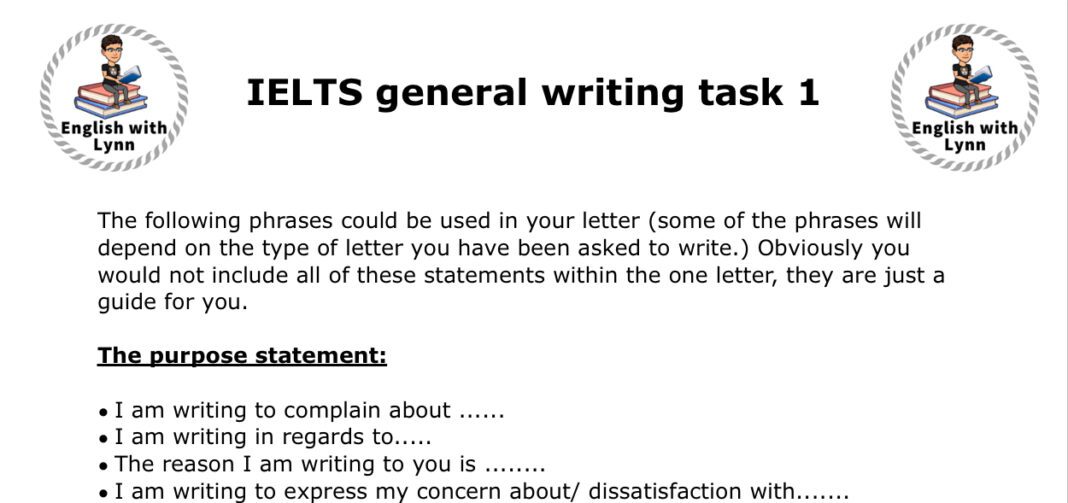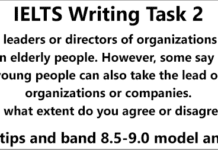IELTS Letter Writing Structure
Create the perfect Task 1 letter with this easy to learn IELTS letter writing structure.
The 6 part structure:
1) Dear …..
2) Paragraph 1: Purpose – why you are writing
3) Paragraph 2: Write about 1st bullet point
4) Paragraph 3: Write about 2nd bullet point
5) Paragraph 4: Write about 3rd bullet point
6) Signoff
In this lesson, I show you how to use it.
Question Structure
We’ll start by looking at a sample question as I want you to see how this IELTS letter writing structure mirrors the format of the questions.
The structure of every question is the same. It contains 3 parts:
Part 1 – The topic.
Part 2 – The person you must write to.
Part 3 – What you should write about (listed as 3 bullet points).
Here’s our sample question. I’ve used the same colour-coding to highlight the 3 different parts.
Sample Question
You have recently taken a two-day course.
Write to the course organiser to give your feedback. In your letter:
- give details of the course
- say what you liked or disliked about it
- suggest some improvements to the course.
How To Use the IELTS Letter Writing Structure
Now, we’ll return to the letter structure and fill in the detail from the question to create a plan for our letter.
1) Dear …..
2) Paragraph 1: Purpose – to give feedback on the two-day course
3) Paragraph 2: give details of the course (bullet point 1)
4) Paragraph 3: say what you liked or disliked about it (bullet point 2)
5) Paragraph 4: suggest some improvements to the course (bullet point 3)
6) Signoff

It’s time to start writing our letter. I’m going to focus on paragraphs 2, 3 and 4 as these will form the main body of the letter but first, we’ll quickly write the greeting and the purpose paragraph to give the context for our letter.
(You’ll find help on how to think up ideas for all parts of the letter in the lesson on Planning Your Letter and in the lessons on The 7 Different Question Topics. The aim of this lesson is to get you familiar with the IELTS letter writing structure.)
1) The Greeting
We are not writing to a friend, so the tone of the letter will be formal. We don’t know the course organiser so we will use ‘sir’ or ‘madam’ as the greeting, i.e. ‘Dear Sir’/’Dear Madam’.
2) The Purpose
To give feedback on the two-day course.
State the reason that you are writing in one simple sentence. Use synonyms of key words used in the question where possible.
Example:
I am writing to give you an evaluation of the TEFL course I took at Exeter College last weekend.
Now for the 3 main paragraphs. Follow the IELTS letter writing structure and these guidelines.
- Each paragraph should be about 50 words in length.
- It must fully develop the topic of the bullet point.
- Write about the bullet points in the order they appear in the question.
- Use key words from the bullet point or use synonyms that make it clear which one you are writing about.
- Leave a line between each paragraph to create a clear separation between them.
And here are some ideas of what you could write for the 3 main paragraphs.
3) Paragraph 2
Give details of the course (bullet point 1)
Example:
Although there were 10 hours of classes each day, I did not find the days as exhausting as I had feared because there was a good mix of theory and practical sessions. The different styles of teaching from the various tutors also helped to keep everyone engaged and motivated.
4) Paragraph 3
Say what you liked or disliked about it (bullet point 2)
Example:
I particularly enjoyed the group work as I learnt a lot from the other students and had fun doing the activities with them. Changing the groups around each time so that we worked with different people was a great idea. There were also excellent handouts from all the sessions.
5) Paragraph 4:
Suggest some improvements to the course (bullet point 3)
Example:
My only criticism of the course is the lack of time given for the individual teaching practices we had to do each day. I do understand that with 20 people on the course, they did take up a lot of time, but 2 minutes per presentation was not long enough to practice all we had learnt. Addressing this issue would make an excellent course even better.
6) Signoff
Now we just have to sign off and our letter is complete.
For a formal letter, there are two options. The correct one will depend on who you are addressing:
- Dear Sir (name unknown) – Yours faithfully
- Dear Mr Jones (name known) – Yours sincerely
We don’t know the name of the person we are writing to so we must use ‘Yours faithfully’.
Here are the six parts of our letter brought together.
The Finished Letter
Dear Sir,
I am writing to give you an evaluation of the TEFL course I took at Exeter College last weekend.
Although there were 10 hours of classes each day, I did not find the days as exhausting as I had feared because there was a good mix of theory and practical sessions. The different styles of teaching from the various tutors also helped to keep everyone engaged and motivated.
I particularly enjoyed the group work as I learnt a lot from the other students and had fun doing the activities with them. Changing the groups around each time so that we worked with different people was a great idea. There were also excellent handouts from all the sessions.
My only criticism of the course is the lack of time given for the individual teaching practices we had to do each day. I do understand that with 20 people on the course, they did take up a lot of time, but 2 minutes per presentation was not long enough to practice all we had learnt. Addressing this issue would make an excellent course even better.
Yours faithfully,
Jacky Spear
(189 words)
Use this IELTS letter writing structure as you practice for your exam. Study the lessons in the menu below to learn the other skills you need to write high-scoring letters.
IELTS General Letter Writing Structure IELTS General Letter Writing Structure IELTS General Letter Writing Structure






